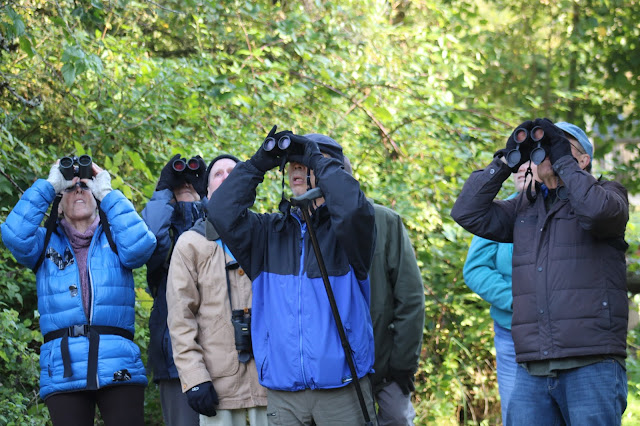I go out to Nisqually Refuge on Wednesday mornings every chance I get. The weekly bird walk is led by great Volunteers, and the knowledge of the birders makes it a great way to spend a morning.
 |
| Refuge Volunteer Coordinator (and awesome birder) David True briefs the morning crowd |
Today, I went out there on
a mostly clear 36º F morning. There were
nearly 30 participants, including a couple from Pittsburgh, PA. It's always neat to have birders from "Away" to share your day with!
The contractors
are still working on the bridge on the estuary boardwalk, so the Wednesday walk is
truncated partway down the north dike.

Highlights today included seeing the Great Horned Owl along the east
boardwalk, and a Whimbrel out on the mudflats.
We had a 13.3
high tide at 9:15 a.m., so there was lots of mud on the falling tide when we
got to the reclamation area. At the
visitor center we had Mallards, Hooded Mergansers, Wood Ducks and a Wilson’s
Snipe. The pond has quite a few nutrients in it, because it is diked and doesn't drain, so there's quite a growth of Duckweed (Lemna species) to feed the summer ducks.
The orchard was active,
and the birders got to see Bushtits, a Red-breasted Sapsucker, Black-capped and
Chestnut-backed Chickadees, Pileated and Downy Woodpeckers, Ruby- and Golden-crowned
Kinglets, and quite a few American Robins. |
| A male Red-shafted Flicker works the pear tree in the orchard. . . |
It was also active out on the north dike. An American Kestrel made feints at Western Meadowlarks,
and lots of shorebirds were on the saltwater side. A Peregrine Falcon was in the snag of the “Peregrine Tree”
just north of the Center.
The boardwalk
along the Visitors’ Center pond is always good for viewing our “Tree Frog”, now
known as the Pacific Chorus Frog, Pseudacris regilla.
 |
| There's more here than just cattails . . . |
These are pretty small little green guys, and it's easy to walk right past them.
A study of the Pacific Chorus frog’s ability to change color was done by Stegen et al.
(2004). To paraphrase their work, they
found that the rate of color change was faster on the green versus the brown
background. Color-change is not only a
way for the frogs to match their background, but it was also a way to thermoregulate
and hydro-regulate. Who knew? Trust the scientists!
 |
| . . . when you look closely |
 |
| Here's one of the brown ones |
The Refuge Volunteers host a weekly walk - Wednesdays at 8 a.m. at the Visitors' Center. Hope to see you there sometime!
Nisqually NWR
eBird Checklist is Here







No comments:
Post a Comment